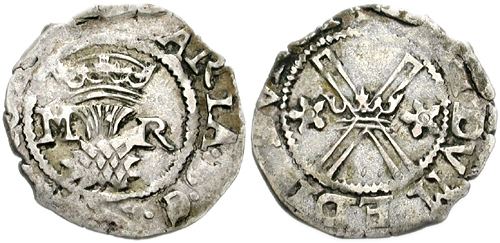 | ||
A bawbee was a Scottish halfpenny. The word means a debased copper coin, valued at six pence Scots (equal at the time to an English half-penny), issued from the reign of James V of Scotland to the reign of William II of Scotland. They were hammered until 1677, when they were produced upon screw presses.
Contents
Issues
The bawbee was introduced by James V in 1538, valued at sixpence. These carry his 'I5' monogram flanking a crowned thistle, and a large saltire on the reverse with a central crown. There was also smaller half bawbee and quarter bawbee. Around the year 1544 his widow Mary of Guise minted bawbees at Stirling Castle, with the 'MR' cipher, and the cross potent with crosslets of Lorraine on the reverse. The first bawbees of Mary, Queen of Scots issued by the mint at Holyroodhouse in Edinburgh carried the cinquefoil emblems of Regent Arran.
The issue of King Charles II was a coin of copper with the famed reverse inscription Nemo me impune lacessit ("No one provokes me with impunity"), although the last word on these coins was spelled "Lacesset". This motto is still in use today on the edge of the circulating Scottish one Pound Sterling coins. The motto is around a crowned thistle followed by the date. This coin was valued at six pence Scots or half an English penny.
Etymology
According to Brewer's Dictionary of Phrase and Fable,
The word "bawbee" is derived from the Laird of Sillebawby, a mint-master. That there was such a laird is quite certain from the Treasurer's account, September 7th, 1541, "In argento receptis a Jacobo Atzinsone, et Alexandro Orok de Sillebawby respective."This Master of the Mint, appointed by James V, was responsible for the introduction of a silver coin valued at six, later three, pennies Scots, which was named after his estate. Sillebawby was a farm in the parish of Burntisland in Fife, a moorland portion of the farm of Balbie (pronounced 'bawbee' (/bɔː biː/)). Its name takes various forms throughout its recorded history: Sybbable (1328), Slebalbe (1328 and 1458), Selybawbey (1517) are some early examples. The later examples Silverbabie (1642), Silver-baby (1654) and Silverbarton (1828 and current) may have arisen from a nickname marking the connection to the silver coin.
Brewer's also gives an alternative etymology, and states its origin from "French, bas billon, (debased copper money)", but this is a kind of speculative folk-etymology.
